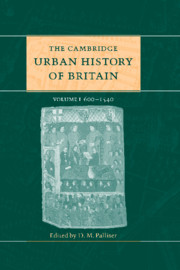Book contents
- Frontmatter
- Part I Introductory
- Part II The early middle ages 600–1300
- Part III The later middle ages 1300–1540
- 12 General survey 1300–1540
- 13 Government, power and authority 1300–1540
- 14 The economy of British towns 1300–1540
- 15 Urban culture and the Church 1300–1540
- 16 The built environment 1300–1540
- 17 London 1300–1540
- 18 The greater towns 1300–1540
- 19 Port towns
- 20 Small towns 1270–1540
- Part IV Regional surveys
- Part V Conclusion
- Appendix: Ranking lists of English medieval towns
- Select bibliography
- Index
- References
12 - General survey 1300–1540
from Part III - The later middle ages 1300–1540
Published online by Cambridge University Press: 28 March 2008
- Frontmatter
- Part I Introductory
- Part II The early middle ages 600–1300
- Part III The later middle ages 1300–1540
- 12 General survey 1300–1540
- 13 Government, power and authority 1300–1540
- 14 The economy of British towns 1300–1540
- 15 Urban culture and the Church 1300–1540
- 16 The built environment 1300–1540
- 17 London 1300–1540
- 18 The greater towns 1300–1540
- 19 Port towns
- 20 Small towns 1270–1540
- Part IV Regional surveys
- Part V Conclusion
- Appendix: Ranking lists of English medieval towns
- Select bibliography
- Index
- References
Summary
A century ago the most famous of all Cambridge historians of the medieval English town declared that he was ‘far from thinking that any one history should be told of all our boroughs’. In some ways F. W. Maitland has proved even wiser and more prophetic than he knew. For many of its readers this present volume may itself suggest that a truly unified history of late medieval British towns is an unattainable ideal. The more intensive the research conducted on individual late medieval towns in recent years, the more apparent seems the singularity of each urban place. Because of the nature of the surviving evidence, nearly all late medieval boroughs tend to be studied as if they were autonomous islands in a non-urban sea – even if in fact their insularity was always more apparent than real. The economic fortunes of all major provincial English towns, from Exeter to Newcastle, were dependent not only on external political, administrative and social pressures but also on all-pervasive networks of national and international trade like those which made them increasingly vulnerable to competition from London merchants in the years before and after 1500. Moreover, when one is able, only too rarely, to examine variations in a town's population and productivity at extremely close quarters during a brief period of time, what tends to be revealed is not stability but a situation of continuous and even alarming short-term volatility. It was only after the middle ages were over that new economic and political structures, and eventually the processes of mass industrialisation, gradually began to impose a greater degree of social equilibrium within what had previously been a more or less permanently ‘crisis-ridden’ urban scene.
- Type
- Chapter
- Information
- The Cambridge Urban History of Britain , pp. 271 - 290Publisher: Cambridge University PressPrint publication year: 2000
References
- 1
- Cited by



